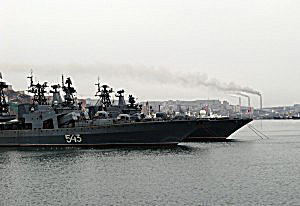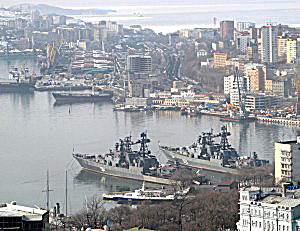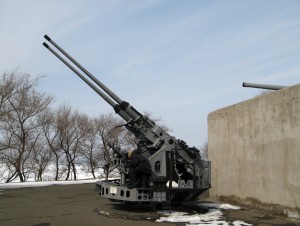When I was a lad, Vladivostok was impossibly exotic, remote and inaccessible. It was a closed city, the home of the jealously guarded Soviet Pacific Fleet, inaccessible to regular Soviet citizens, let alone wicked foreigners.
 Well, nowadays a standard Russian tourist visa will let you enter Vladivostok and you can wander at will around the city. I had vaguely expected that the naval base would still be hidden away, discreetly veiled from touristic eyes. But no! Back in the day, there was no need to hide it, since the whole city was a closed area. So today the remaining ships of the Russian Pacific Fleet sit quietly in the main harbor, visible to all.
Well, nowadays a standard Russian tourist visa will let you enter Vladivostok and you can wander at will around the city. I had vaguely expected that the naval base would still be hidden away, discreetly veiled from touristic eyes. But no! Back in the day, there was no need to hide it, since the whole city was a closed area. So today the remaining ships of the Russian Pacific Fleet sit quietly in the main harbor, visible to all.
 I took the funicular up to Eagle’s Nest Hill, for a fine (albeit hazy) view of the Golden Horn harbor and various Russian warships. I nervously took a few snaps. Some part of me was still vaguely expecting the heavy hand of Soviet Power to drop on my shoulder. Far from it: a random tourist taking snapshots in today’s Russia is not a big deal. (And in the age of high resolution satellites, random tourist snaps are probably neither here nor there.)
I took the funicular up to Eagle’s Nest Hill, for a fine (albeit hazy) view of the Golden Horn harbor and various Russian warships. I nervously took a few snaps. Some part of me was still vaguely expecting the heavy hand of Soviet Power to drop on my shoulder. Far from it: a random tourist taking snapshots in today’s Russia is not a big deal. (And in the age of high resolution satellites, random tourist snaps are probably neither here nor there.)
For dessert, I wandered over to the the charming Vladivostok Fortress Museum. As well as the fortress exhibits, this has many fine Soviet military toys outside and you are encouraged to clamber over the guns and even elevate or rotate the small ones.
Side note: When I was in Karaganda (Kazakhstan) I had been puzzled to find a significant number of ethnic Koreans there, supposedly resettled there by Stalin. Well, when the Tsars founded Vladivostok (“Lord of the East”) as their great Pacific base, it was in an area settled by ethnic Koreans. Much later, like other ethnic groups straddling the USSR’s frontiers, they were deemed a security risk by Stalin and exiled to the Kazakh steppes.
